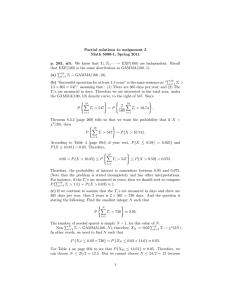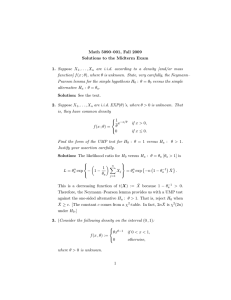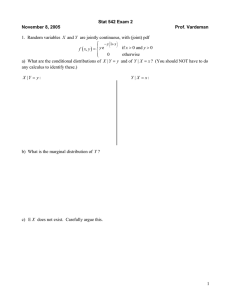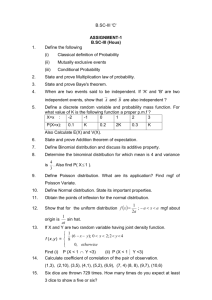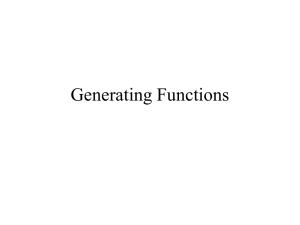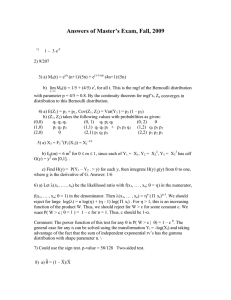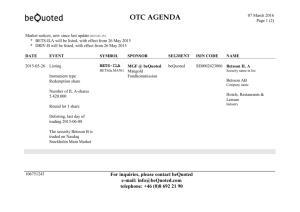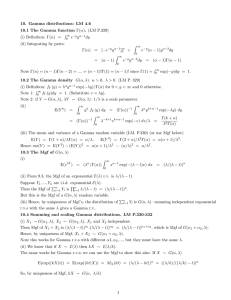Moment-generating functions and independence
advertisement
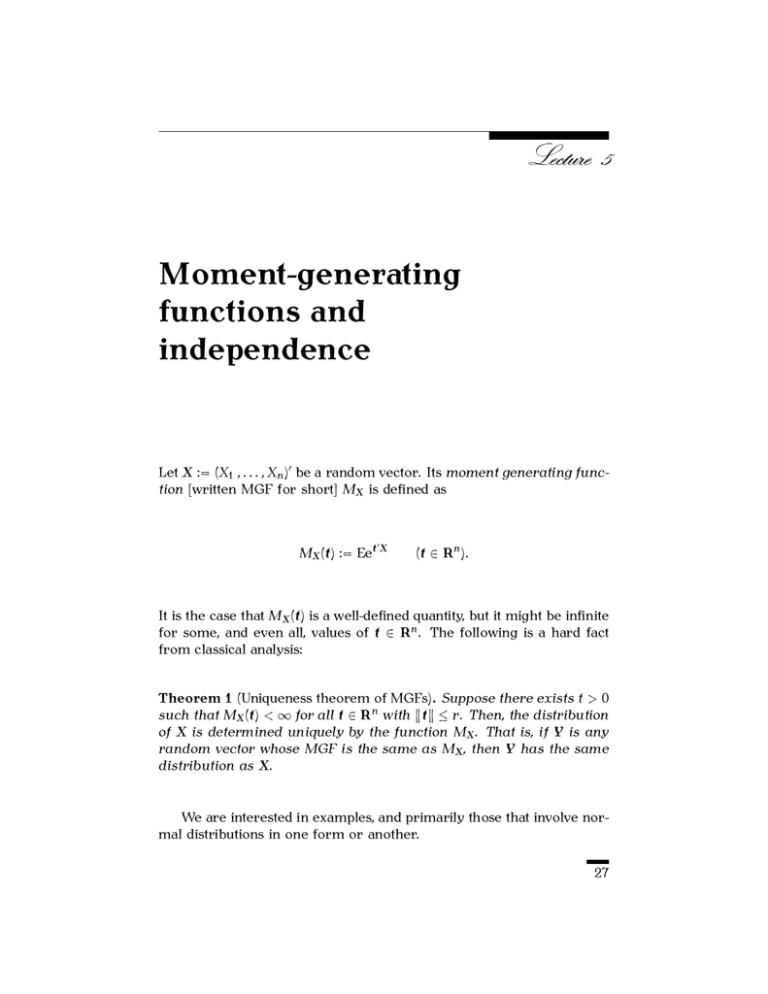
Moment-generating
functions and
independence
Let X := (X1 � � � � � X� )� be a random vector. Its moment generating function [written MGF for short] MX is defined as
�
MX (�) := Ee� X
(� ∈ R� )�
It is the case that MX (�) is a well-defined quantity, but it might be infinite
for some, and even all, values of � ∈ R� . The following is a hard fact
from classical analysis:
Theorem 1 (Uniqueness theorem of MGFs). Suppose there exists � > 0
such that MX (�) < ∞ for all � ∈ R� with ��� ≤ �. Then, the distribution
of X is determined uniquely by the function MX . That is, if Y is any
random vector whose MGF is the same as MX , then Y has the same
distribution as X.
We are interested in examples, and primarily those that involve normal distributions in one form or another.
27
28
5. Moment-generating functions and independence
Example 2. If X ∼ N(µ � σ 2 ), then
� ∞
−(�−µ)2 /(2σ 2 )
�X
�� e
√
d�
MX (�) = Ee =
e
2πσ 2
−∞
� ∞
−� 2 /2
�(σ�+µ) e
√
=
e
d�
(� := (� − µ)/σ)
2π
−∞
� ∞ �σ�−� 2 /2
� ∞ − 1 [� 2 −2��σ ]
e
e 2
�µ
�µ
√
√
=�
=e
d��
2π
2π
−∞
−∞
We complete the square [� 2 − 2��σ = (� − �σ)2 − (�σ)2 ] in order to see
that
�
�
�2σ 2
MX (�) = exp �µ +
�
2
Therefore, the uniqueness theorem (Theorem 1) tells us that any random
variable Y whose MGF is MY (�) = exp(�µ+ 21 � 2 σ 2 ) is distributed according
to N(µ � σ 2 ).
�
Example 3 (MGF of a simple multivariable normal). Suppose X� ∼
N(µ� � σ�2 ) (1 ≤ � ≤ �) are independent. Then, the MGF of X := (X1 � � � � � X� )�
is
�
�
�
�
�
�
�
�
1 2 2
�
1
MX (�) = Ee� X =
Ee�� X� =
e�� µ� + 2 �� σ� = exp
�� µ� +
��2 σ�2
2
for all � ∈ R� .
�=1
�=1
�=1
�=1
�
Example 4 (MGF of χ12 ). If X is standard normal, then Y := X 2 ∼ χ12 .
Now
� ∞ �� 2 −� 2 /2
2
e
√
d�
MY (�) = Ee�X =
2π
−∞
�
�
� ∞
1
1
2
=√
exp − (1 − 2�)�
d��
2
2π −∞
If � ≥√1/2, then the preceding is infinite. Otherwise, a change of variables
[� = 1 − 2� �] tells us that it is equal to
� ∞ −� 2 /2
e
d�
1
√
√
=√
�
1 − 2�
1 − 2�
2π
−∞
In other words, MX2 (�) = ∞ if � ≥ 1/2 and MX2 (�) = (1−2�)−1/2 if � < 1/2.
�
5. Moment-generating functions and independence
29
Example 5 (MGF of χ�2 ). Let X1 � � � � � X�
� ∼ N(0 � 1) be independent, and
consider the χ�2 random variable Y := ��=1 X�2 . Its MGF is
�
�
�
(1 − 2�)−�/2 if � < 1/2�
MY (�) =
MX2 (�) =
�
∞
if � ≥ 1/2�
�=1
According to Theorem 1, this is a formula for the MGF of the χ�2 distribution, and identifies that distribution uniquely.
�
Theorem 6 (Independence theorem of MGFs). Let X be a random �vector with a MGF that is finite in an open neighborhood of the origin
0 ∈ R� . Suppose there exists � = 1� � � � � � such that
MX (�) = MX (�1 � � � � � �� � 0 � � � � � 0) · MX (0 � � � � � 0 � ��+1 � � � � � �� )
for all � ∈ R� . Then, (X1 � � � � � X� ) and (X�+1 � � � � � X� ) are independent.
Proof. Let X̃ denote an independent copy of X. Define a new random
vector Y as follows:
X1
..
.
X�
Y :=
X̃�+1 �
..
.
Then,
X̃�
MY (�) = MX (�1 � � � � � �� � 0 � � � � � 0) · MX (0 � � � � � 0 � ��+1 � � � � � �� )�
According to the condition of this theorem, X and Y have the same
MGF’s, and therefore they have the same distribution (Theorem 1). That
is, for all sets A1 � � � � � A� ,
P {X1 ∈ A1 � � � � � X� ∈ A� } = P {Y1 ∈ A1 � � � � � Y� ∈ A� } �
which is, by construction equal to
�
�
P {X1 ∈ A1 � � � � � X� ∈ A� } · P X̃�+1 ∈ A�+1 � � � � � X̃� ∈ A� �
Since X̃ has the same distribution as X, this proves that
P {X1 ∈ A1 � � � � � X� ∈ A� } = P {X1 ∈ A1 � � � � � X� }·P {X�+1 ∈ A�+1 � � � � � X� ∈ A� } �
which has the desired result.
�
